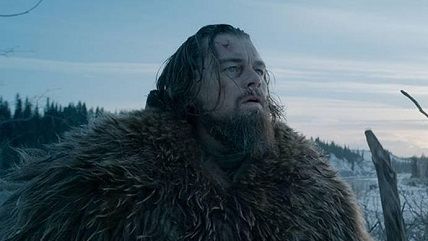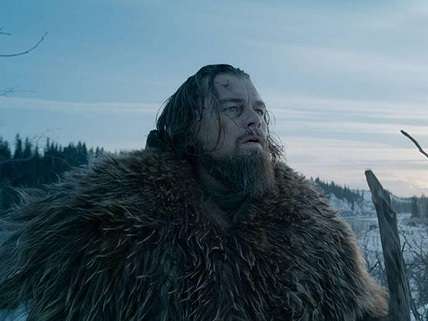Movie Review: The Revenant
Leonardo DiCaprio and Tom Hardy in a brutal tale of survival and revenge.


Leonardo DiCaprio is an icon of human endurance in The Revenant, Alejandro G. Iñárritu's harrowing, two and a half hour survival epic. But the movie's true star is cinematographer Emmanuel Lubezki, who captures the movie's vast frozen landscapes and blood-drenched battles with spectacular artistry. Lubezki has already won two Oscars—for Gravity (2013) and Iñárritu's Birdman or (The Unexpected Virtue of Ignorance) (2014)—and he seems certain to be nominated once again for his work here. Without it, this grim picture might have proved an insurmountable challenge to the endurance of its audience.
The story is loosely drawn from a 2002 novel by Michael Punke, which recounts the semi-legendary tale of Hugh Glass, a 19th Century hunter with the Rocky Mountain Fur Company. On an 1823 expedition along the snowy northern reaches of the Missouri River, Glass was grievously mauled by a grizzly bear and left for dead by his fellow hunters. But he lived—a revenant returned from the valley of death—and with no weapons and little food or clothing, he limped, crawled and occasionally rode a horse some 200 miles back to the company's trading outpost to confront the men who abandoned him.
Iñárritu launches the movie with a furious attack on the hunting party by local Indians, who are understandably inflamed by this latest incursion into their homeland by rapacious white interlopers. One moment the hunters are skinning the pelts off the animals they've felled; the next, the sky is filled with flights of arrows. Lubezki's camera wades deep into the gory action (there's an arrow-to-the-head closeup that's really startling), and after nearly three dozen of the hunters have been slaughtered, it follows the survivors as they make their escape – barely -- on a primitive river boat.
Among this group are Glass (DiCaprio), his half-Pawnee son Hawk (Forrest Goodluck), good-hearted expedition leader Captain Henry (Domhnall Gleeson), and a black-hearted hunter named Fitzgerald (Tom Hardy). Returning to shore, they make their way up muddy hills and through bone-chilling waters on their long journey back to the company headquarters. Then the grizzly appears, igniting a scene of hair-raising brutality.
This huge bear is presumably computer-generated—but it's CGI at a breathtaking new level of detail. Glass, with flintlock rifle in hand, is stalking through the woods on his own; the bear, protecting its cubs, charges. It seizes the lone hunter in its jaws and whips him about like a rag doll (Lubezki moves in so close to this creature that its breath—well, "breath"—fogs his lens). The bear's enormous claws rake Glass's flesh, leaving him with exposed bones on his back and a hole in his throat. When the other hunters find him, Captain Henry has Glass strapped to a sledge to be taken along on the trip back home. Very soon, though, Henry realizes that Glass is on the brink of death. Determined to move on, he has three of the men—Fitzgerald and Hawk and a timid young hunter named Bridger (Will Poulter)—remain behind with the dying man in order to bury him when he expires. This leads to a new spasm of horror, precipitated by Fitzgerald, and soon Glass is left alone in the wilderness.
The rest of the movie focuses largely on Glass's trials and survival stratagems, with DiCaprio going all in on a quest for maximum verismo. We see the actor sucking marrow from animal bones, biting into a live fish, eating an actual raw buffalo liver. Desperate for warmth, he guts a horse and crawls inside its bloody carcass. He cauterizes the wound in his throat in an alarming way, and is forced to deal with further threats by hostile Indians and a band of wily French fur traders. He also meets a sympathetic Indian who helps tend his wounds, but then he gets chased off a cliff. When he finally makes it back to the company outpost, his pursuit of the scummy Fitzgerald begins.
The director's Herzogian determination to film almost entirely in arduous locations, using only natural light, resulted in a seven-month shoot (including a relocation to Argentina when the weather in Canada, where filming began, proved insufficiently miserable). One can only imagine the hardships the actors endured. DiCaprio, his beard stiff with ice, maintains a formidable commitment to his character—although his Glass is so preoccupied with surviving that there's no room for character development. And Hardy—nearly unrecognizable with a scruffy beard and a half-scalped head—is equally magnetic: his Fitzgerald is a disturbing emblem of mumbly malevolence.
Iñárritu mostly suppresses his inclination for arty surrealism (although one shot of a woman hovering in midair cries out to be cut). He has made a movie that's both savage and beautiful, and, for better and possibly worse, unlike any other. You'll probably be glad you saw it, but may feel no immediate need to see it again.